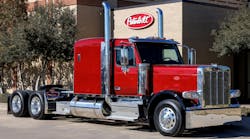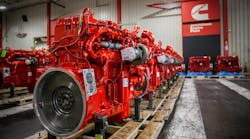Growing numbers of tank trucks fleets and other trucking companies are being lurred by the siren song of riches in the latest oilfield boom. It's just plain wild, especially in the areas that contain the largest oil and gas shale formations.
In one South Texas country in the Eagle Ford shale play, 100 drilling permits were issued in 2010. That same county issued 200 drilling permits this year, and it takes a tremendous number of trucks to support all of that activity, according to Les Findeisen, director of policy at the Texas Motor Transportation Association, who spoke during the National Tank Truck Carriers' fall regional Safety & Security Council meeting October 13 in Houston TX.
"Trucks are used to haul everything the drilling rig needs to operate, and trucks also transport crude oil and various waste products," he said. "Several pipelines are in the development in the Eagle Ford shale area, but it will be some time before any of them are operational. However, one 20-inch pipeline could displace approximately 1,250 tank trailer movements of crude oil per day."
While the opportunities are big, there are also significant challenges for tank truck fleets tempted by the oil and gas shale drilling activity. "It's very important for trucking companies to do their due diligence before signing any contracts for oilfield hauling," Findeisen said. "You need to know what's going on in the areas where you would be operating."
Good qualified drivers are in short supply, and many of the people flocking to the oilfield can't meet some of the most basic qualifications. "We've been told that 70% of the job applicants in the Eagle Ford area failed their drug tests," Findeisen said.
Reports also suggest that some truck drivers are working despite suspended commercial driver licenses. Texas reportedly is setting up a program to help carriers do a more effective job of screening oilfield drivers.
Fleets that bring their own drivers face the risk of losing them over pay issues. "Driver wages in many of these oil and gas shale areas are in the range of $26.50 an hour with 70 hours a week guaranteed," Findeisen said. "That adds up to $1,850 a week and could mean an annual income of more than $96,000."
Finding someplace for drivers and other fleet personnel to live can be an issue. Houses and apartments are in short supply or simply aren't available. Spaces for recreational vehicles and mobile homes rent for $450 a month in the Eagle Ford shale area, according to Findeisen.
Equipment needs to be spec'd for oilfield conditions. "The county roads in the Texas oil and gas shale areas were never designed for the volume and weight of oilfield truck traffic," he said. "Many of these roads have been torn up so badly that the state is turning them back to gravel. "Oil and gas companies are looking at some sort of fee to cover the cost of repairing and maintaining the roads."








